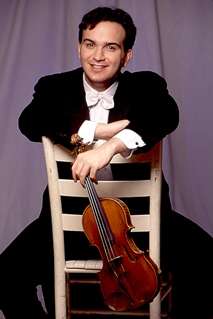|
Back
Turning the Warhorse Into A Pegasus New York
David Geffen Hall, Lincoln Center
08/17/2017 - & August 19, 2017
Sergei Prokofiev: Symphony No. 1 in D Major (“Classical”), opus 25
Wolfgang Amadeus Mozart: Symphony No. 25 in G Minor, K. 183
Peter Ilych Tchaikovsky: Violin Concerto in D Major, opus 35
Gil Shaham (Violin)
Mostly Mozart Festival Orchestra, Louis Langrée (Conductor)

G. Shaham (© Boyd Hagen)
“The Tchaikovsky Violin Concerto gives us the hideous notion that music can stink up the ears.”
Critic Eduard Hanslick, in Neue Frei Presse, 1881
Even the most cultivated critic will give the knee-jerk reaction to a concert like this: “Not another &^%*$ Tchaikovsky Violin Concerto”.
The exception to those previous cerebral thoughts, though, is when the soloist is Gil Shaham. For the ever youthful Mr. Shaham and his Comtesse de Polignac" 1699 Stradivarius violin plays anything but “another” Tchaikovsky concerto.
Not that he is idiosyncratic in any way. The notes are the same, he takes no weird paths from the cadenza, and the final movement has all the usual Slavic flashing-flaunting velocity it deserves. The difference is that Mr. Shaham has a tone in the medium high registers which is burnished with the finest gold. He plays that first movement cadenza as though it was his initial reading, seeming to improvise those double-stringed harmonies. He takes the second movement with an operatic lyricism. Yes, a bit slow, almost–almost–leaning over to melancholic Weltschmerz but never going over the edge. And in the final movement last night, with Louis Langrée and the Mostly Mozart Festival Orchestra leaping to catch up with him, Mr. Shaham peppered up the tempo, edged onto Gypsy wildness but returned to the Russian melodies before pumping up the music to a dazzling finale.
Where does Mr. Shaham find such a thrilling way to guide an old warhorse? First of all, his personal experience. Born in Illinois, growing up in Jerusalem, educated in Israel and New York (Juilliard and Columbia), where he lives with his violinist wife. But that doesn’t explain the innate genius, where is able to harvest his emotions–for he never holds back–to produce notes that are incandescent in the fast movement, darkly glowing in the Andante.
The first themes of the opening movement were not Tchaikovsky “tunes”, they were regal statements, later to be broadened out up to the splendid cadenza. The second movement had that slow yearning sensation, yet Mr. Shaham never had to pause, to give emotional tugs: the sounds were enough.
And in that finale, which every fiddler takes at the fastest possible speed, Mr. Shaham didn’t hold back. But the Gil-and-Strad equation gave this movement a clarity. So even then composer calls for a breath and a pause, one knows that Mr. Shaham could play the fireworks for a virtual perpetuity.
Coming to the end of the Mostly Mozart Festival, Louis Langrée had his Mostly Mozart Festival Orchestra at their best. Then again, Mr. Langrée himself has the movements of a Lully-style conductor for Louis XIV, so the faux-Haydn Prokofiev First Symphony was given a dancing performance. While many a composer tries to imitate styles, only Prokofiev (and perhaps Ravel in a different way) pulled off such a trick successfully.
The first three movements here had almost similar tempos, but nobody cared, since the Russian’s invention was so smooth. And if the last movement wasn’t quite crystalline, the velocity was its own reward.
The Mostly Mozart Orchestra, by the way, is a pretty good ensemble, but their woodwind section is above excellent, and they had so many chances, both here and the following Mozart 25th.
This “little G Minor” is an early work (Mozart wrote it at 17), but it can be fierce and, within 18th Century terms, with an almost savage opening. We are used to that thanks to the late Sir Neville Marriner’s ominous measures opening to Amadeus. Mr. Langrée give it a more stylish feel, those first menacing chords almost tender. That was his purpose, and the second movement followed with lyrical lightness.
The finale was grand enough, but to me, the trio of the third movement, with the Mostly Mozart Orchestra winds, was the highlight of the work.
Not of the evening, though. Mr. Shaham held that honor.
The full-house audience, which correctly never applauded between movements in the Prokofiev and Mozart, were utterly ecstatic after the Concerto opening movement. Rather, they behaved like late 18th Century hoi polloi who would insist on the soloist repeating and repeating again what had been sung or played before.
It never went that far (though a few concertgoers left the auditorium, thinking perhaps the concert was over), but Mr. Shaham simply stopped playing for two minutes before continuing.
And while he may have given an encore, and while I would love to have heard him more, the ending of the Tchaikovsky was so gorgeous that I left immediately, its music still ringing in my memory.
Harry Rolnick
|